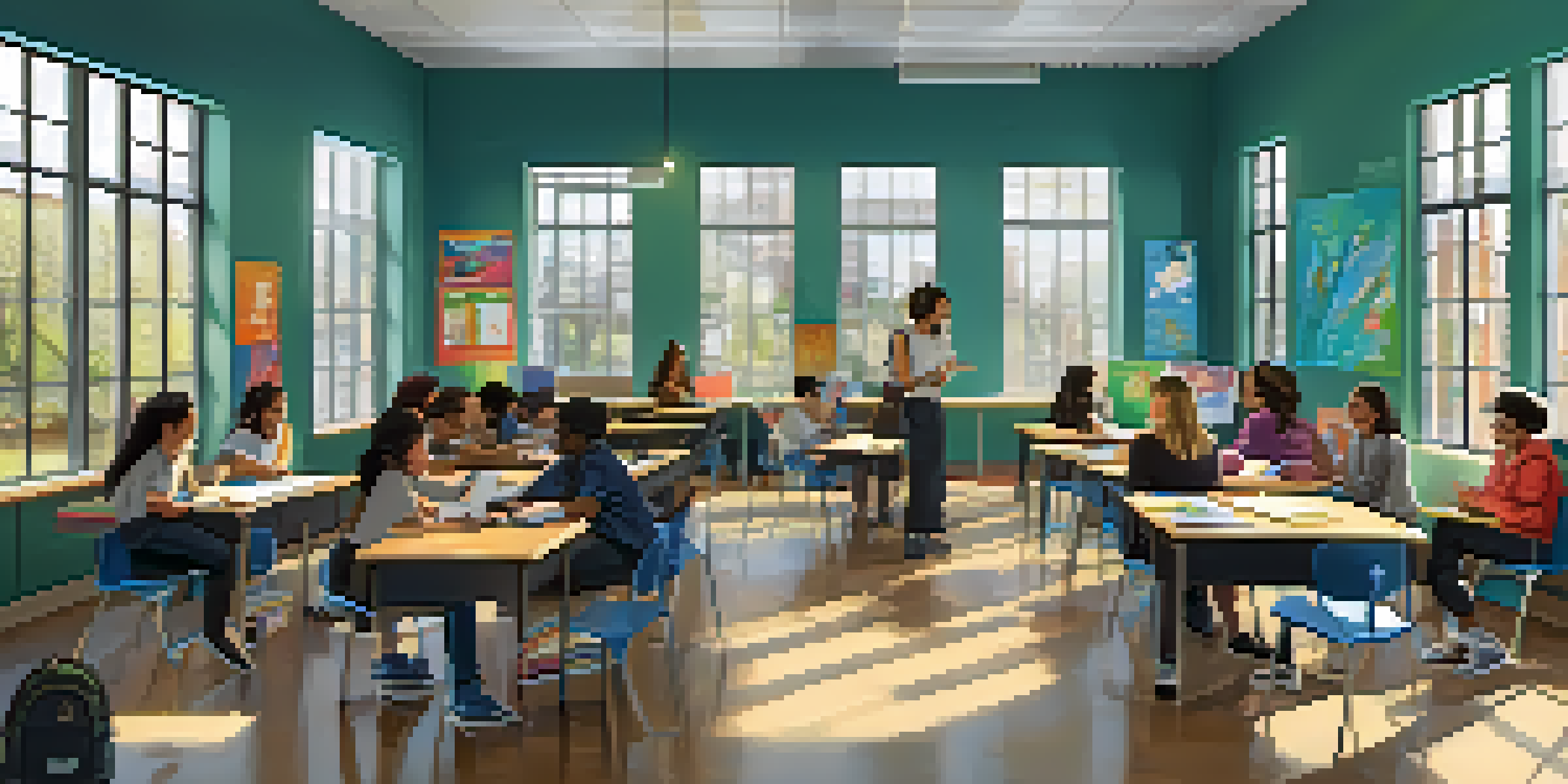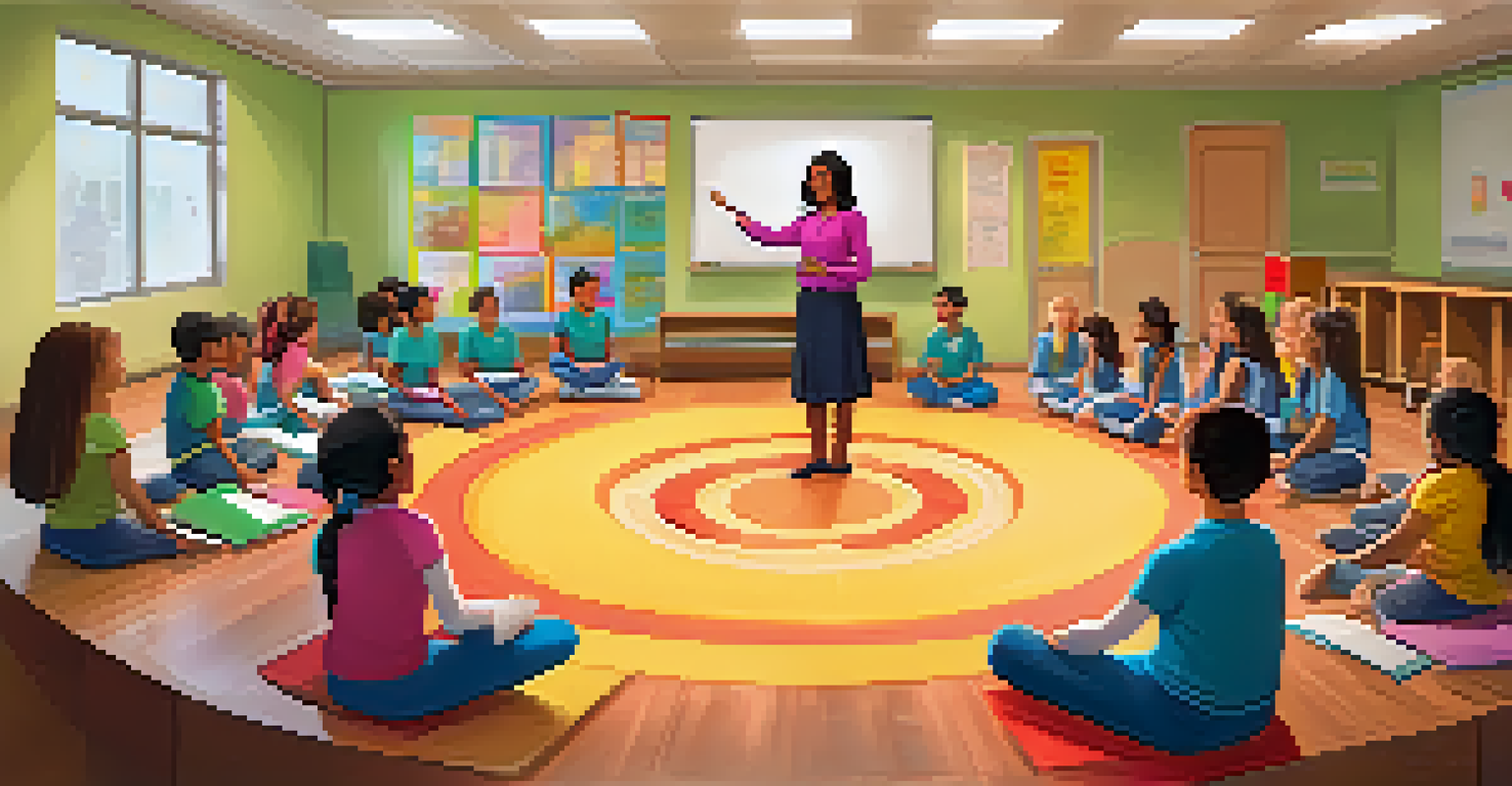Flipped Classroom: Incorporating Mindfulness Practices

Understanding the Flipped Classroom Model
The flipped classroom model is a teaching approach that inverts traditional learning. Instead of introducing new concepts in class, students learn at home through videos or readings, freeing up valuable classroom time for interactive activities. This method allows educators to focus on application, discussion, and hands-on learning during in-person sessions, fostering a deeper understanding of the material.
The greatest gift you can give your students is to teach them how to think, not what to think.
Imagine a classroom where students come prepared, eager to engage in discussions rather than passively absorbing information. This active participation not only enhances comprehension but also encourages collaboration among peers. As a result, students often feel more connected to the content and each other, leading to a more dynamic learning environment.
Integrating mindfulness practices into this model can further enrich the learning experience. By encouraging students to be present and aware during discussions and activities, educators can cultivate a more focused and engaged classroom atmosphere. This synergy between the flipped classroom and mindfulness can create a powerful educational experience.
The Role of Mindfulness in Education
Mindfulness is the practice of being fully present and engaged in the moment, which can significantly impact student learning. By incorporating mindfulness techniques, such as deep breathing or guided meditation, educators can help students manage stress and enhance their focus. This is particularly important in today’s fast-paced world, where distractions are abundant, and attention spans are shorter than ever.

For instance, starting a class with a brief mindfulness exercise can set a positive tone and prepare students for active participation. When students learn to calm their minds and center their thoughts, they're better equipped to absorb information and engage with their peers. This simple practice can lead to improved emotional regulation and resilience in the face of challenges.
Flipped Classrooms Enhance Engagement
The flipped classroom model encourages active participation, allowing students to engage more deeply with the material.
Moreover, mindfulness encourages self-awareness, helping students identify their learning styles and preferences. This awareness can empower them to take charge of their own learning, making the flipped classroom model even more effective as they become active participants in their educational journey.
Integrating Mindfulness with Flipped Learning
To effectively integrate mindfulness within a flipped classroom, educators can utilize various strategies that align with their curriculum. For example, teachers can assign mindfulness videos or readings for home study, allowing students to explore the concept at their own pace. This approach not only sets the stage for deeper classroom discussions but also encourages students to reflect on their learning experiences.
Mindfulness isn’t difficult, we just need to remember to do it.
During in-class time, educators can incorporate mindfulness practices between activities. A few minutes of focused breathing or a short meditation can help students transition from one topic to another, enhancing their concentration and retention of the material. These mindful breaks can serve as powerful tools for recharging and refocusing, ultimately leading to a more productive learning environment.
Additionally, collaborative mindfulness activities can foster teamwork and communication skills. By engaging in group mindfulness exercises, students learn to support one another, creating a sense of community and belonging. This collaborative spirit can enhance the overall effectiveness of the flipped classroom model, making learning a shared journey.
Benefits of Mindfulness in a Flipped Classroom
The benefits of integrating mindfulness into the flipped classroom model are numerous. Firstly, students often report feeling more relaxed and focused, which enhances their ability to engage with the material. This heightened state of awareness can lead to improved academic performance, as students are better equipped to absorb and retain information.
Moreover, mindfulness practices can help reduce anxiety and stress, which are common challenges in academic settings. By teaching students how to manage their emotions effectively, educators can create a more supportive and nurturing environment. This emotional well-being is crucial for fostering a love of learning and promoting long-term educational success.
Mindfulness Supports Learning
Incorporating mindfulness techniques helps students manage stress and enhances their focus, contributing to a more effective learning environment.
Finally, the combination of flipped learning and mindfulness encourages lifelong skills that extend beyond the classroom. Students learn not just academic content but also valuable life skills, such as self-regulation, empathy, and resilience. These skills are essential as they navigate both their educational journeys and personal lives.
Practical Mindfulness Techniques for Educators
Educators looking to incorporate mindfulness into their flipped classroom can start with simple techniques that are easy to implement. One effective method is the use of guided imagery, where students visualize calming scenes to promote relaxation. This can be done at the beginning or end of a lesson to help students clear their minds and prepare for learning.
Another approach is to incorporate short mindfulness exercises during classroom transitions. For example, teachers might lead students in a brief breathing exercise after a video session to help them refocus before diving into discussions. These small moments can make a big difference in maintaining a calm and focused classroom atmosphere.
Lastly, educators can encourage students to practice mindfulness independently by providing them with resources such as apps or articles. Encouraging students to adopt mindfulness as part of their daily routine can empower them to take charge of their mental and emotional well-being, enhancing their overall educational experience.
Challenges and Solutions in Implementation
Despite the clear benefits, integrating mindfulness into the flipped classroom model can come with challenges. Some students may be skeptical about mindfulness practices, viewing them as irrelevant to their learning experience. To overcome this, educators can share personal anecdotes or research highlighting the positive impact of mindfulness on academic success, helping to create buy-in from students.
Another challenge is finding the time to incorporate mindfulness amidst a busy curriculum. Educators can address this by integrating short, effective mindfulness exercises that fit seamlessly into existing lesson plans. For instance, a two-minute breathing exercise can be just as impactful as a longer session, making it easier to implement without sacrificing content coverage.
Collaborative Mindfulness Builds Community
Engaging in group mindfulness activities fosters teamwork and a sense of belonging among students, enriching the overall educational experience.
Finally, consistency is key when it comes to mindfulness practices. Educators should aim to incorporate these techniques regularly, creating a positive feedback loop that reinforces their value. Over time, students will become more accustomed to mindfulness, leading to greater engagement and receptiveness to its benefits.
The Future of Flipped Classrooms and Mindfulness
As education continues to evolve, the combination of flipped classrooms and mindfulness practices represents a promising future. This innovative approach not only addresses the needs of today’s learners but also prepares them for the challenges of tomorrow. By integrating mindfulness, educators can create a more holistic learning environment that values emotional well-being alongside academic achievement.
Furthermore, with the growing emphasis on social and emotional learning (SEL), mindfulness fits naturally into broader educational goals. Schools are increasingly recognizing the importance of nurturing students' emotional health, making mindfulness an integral part of the learning experience. This alignment can help foster a more compassionate and empathetic generation of learners.

In summary, the integration of mindfulness practices into the flipped classroom model can revolutionize education. By prioritizing student well-being alongside academic success, educators can create a dynamic and supportive learning environment that empowers students to thrive both in and out of the classroom.